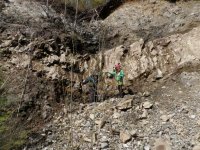hmmm
Hero Member
- Jun 9, 2007
- 830
- 95
- Primary Interest:
- All Treasure Hunting
hello friends 
i have a question about clay i have been testing as a healing type clay. i could use some help with a disturbing test result.
i have a Quantitative Phase Analysis and it shows 20% Actinolite in one of the clays . i have read conflicting things about it.
one site says it is dangerous
, one site says it is a non hazerdous type of asbestos.
1 site says there is fibrous Actinolite and a safe non fibrous Actinolite.
any one want to weigh in on this.
interesting thing , it is a semi precious gem stone.

i have a question about clay i have been testing as a healing type clay. i could use some help with a disturbing test result.
i have a Quantitative Phase Analysis and it shows 20% Actinolite in one of the clays . i have read conflicting things about it.
one site says it is dangerous

, one site says it is a non hazerdous type of asbestos.
1 site says there is fibrous Actinolite and a safe non fibrous Actinolite.
any one want to weigh in on this.

interesting thing , it is a semi precious gem stone.

Upvote
0





